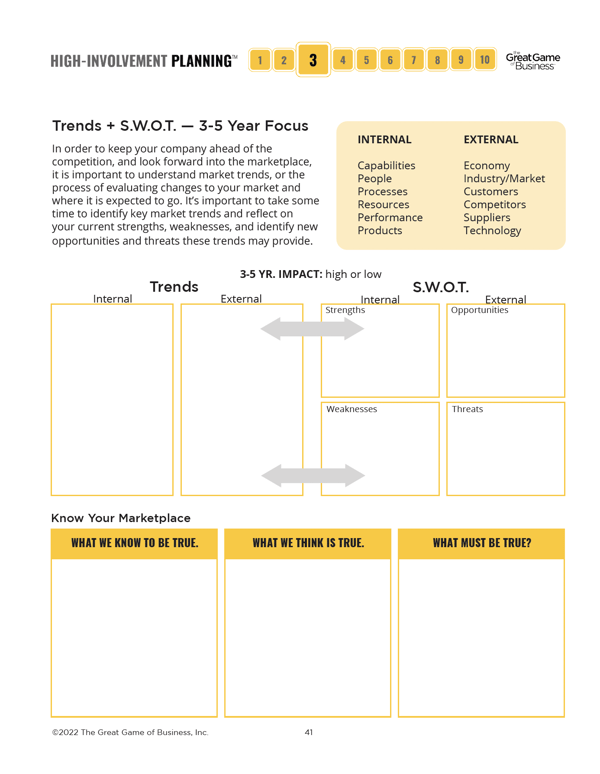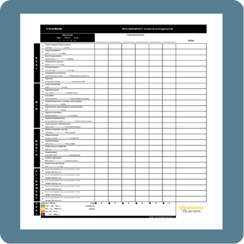What is Long-Range Planning?
Long-range business planning is a process that enables businesses to set goals, create a roadmap for achieving them, and stay ahead of the competition by anticipating future trends and challenges. It involves forecasting the future, assessing the strengths and weaknesses of the business, identifying opportunities and threats, and developing strategies to achieve long-term success. Long-range planning is just 1 of 8 challenges to prioritize when leading through uncertain times.
Why is Long-Range Business Planning Important?
Long-range business planning is crucial for several reasons. First, it enables businesses to set clear and achievable goals, which provide direction and focus for the organization. By having a clear vision of where the business is headed, employees can align their efforts towards achieving the same objective, and the business can work cohesively towards its long-term goals.
Second, long-range business planning enables businesses to stay ahead of the competition. By forecasting future trends and challenges, businesses can prepare themselves for the future, and be ready to take advantage of new opportunities as they arise. This is particularly important in today's fast-changing business environment, where new technologies, changing consumer preferences, and geopolitical developments can impact businesses overnight.
Third, long-range business planning enables businesses to make informed decisions. By assessing the strengths and weaknesses of the business, and identifying opportunities and threats, businesses can make informed decisions about resource allocation, product development, market entry, and other strategic initiatives.
How to Do Long-Range Business Planning
Long-range business planning typically involves several steps. These include:
Define the Vision and Mission of the Business
Defining the vision and mission of the business involves articulating what the business stands for, what it hopes to achieve in the long term, and how it intends to get there. To define a company's vision and mission statement, it is essential to involve key stakeholders, including senior management, employees, and customers. The final vision and mission statement should be communicated clearly and consistently throughout the organization to ensure that everyone is working towards the same long-term goals.
-
Conduct internal and external analysis: The first step in identifying a company's vision and mission is to conduct an internal and external analysis. This involves identifying the company's strengths, weaknesses, opportunities, and threats. It also involves understanding the competitive landscape, market trends, and customer needs.
-
Identify core values: The next step is to identify the company's core values. This includes the principles and beliefs that guide the organization's behavior and decision-making.
-
Define the company's purpose: Once the core values are identified, the next step is to define the company's purpose. This involves articulating the organization's reason for being and what it hopes to achieve.
-
Create a draft of the vision and mission: With the internal and external analysis, core values, and purpose in mind, the next step is to create a draft of the vision and mission. The vision statement should be a forward-looking statement that describes what the organization hopes to achieve in the future. The mission statement should describe the organization's purpose, values, and goals.
-
Review and refine: The final step is to review and refine the vision and mission statements. This involves gathering feedback from key stakeholders and ensuring that the statements accurately reflect the organization's aspirations and purpose. The final vision and mission statements should be communicated clearly and consistently throughout the organization to ensure that everyone is working towards the same long-term goals.

Conduct a SWOT Analysis
This involves assessing the strengths, weaknesses, opportunities, and threats of the business. This step enables businesses to identify areas of competitive advantage, areas that need improvement, emerging opportunities, and potential threats.
To conduct a SWOT analysis, companies can use a variety of methods, including surveys, focus groups, and brainstorming sessions with employees and stakeholders. They can also use data analysis tools to gather data on market trends, customer behavior, and industry benchmarks. Once the SWOT analysis is complete, companies can use the insights gained to develop a strategic plan that addresses their weaknesses, leverages their strengths, takes advantage of opportunities, and mitigates potential threats.

-1.png?width=80&height=70&name=Chat%20Bubble%202%20(1)-1.png)
Download our worksheet to complete a S.W.O.T. analysis and evaluate market trends.
Setting Long-Term Goals and Objectives
This involves setting clear and measurable goals and objectives for the business over the long term. These goals should be aligned with the business's vision and mission, and should be challenging yet achievable. Long term goals should be centered around what the company wants to achieve over the next five to ten years. It's best to identify long-term goals with your team. Doing so will ensure the company is working towards goals agreed upon by the ENTIRE ORGANIZATION rather than goals handed down by the owner. Involving employees in the process of setting goals helps create buy-in and motivation to help hit those goals. After identifying the long-term goals, the next step is to set objectives. These are the specific actions that the company needs to take to achieve its long-term goals. Objectives should be SMART (specific, measurable, attainable, relevant, and time-bound) and should be assigned to specific individuals or teams. Each department should know the specific actions they should be taking to help the company reach its long-term goals.
Developing Strategies to Achieve Long-Term Goals
This involves developing a roadmap for achieving the business's long-term goals. Strategies should be developed for each functional area of the business, including marketing, sales, operations, finance, and human resources. For example, if a shoe store's long-term goal is to increase the total amount of income by 20%, every associate within that shoe store should be aware of the things they can do to help reach that long-term goal. That might mean associates on the floor might have a combined goal to sell "x" number of shoes each year or to reach a certain number of upsells per month. Whatever actions employees can take to drive income should become their sole focus. This helps eliminate tasks that distract employees from achieving long-term goals and gives employees clarity on what's important. After you've outlined strategies to achieve the company's long-term goals, you should develop a schedule or timeline to tie to those strategies. This is especially important for teams responsible for completing multiple tasks a day. A timeline will help teams stay on schedule, let them know when to start different tasks, and help hold them accountable for certain goals. Be realistic when creating timelines. Nobody wants to follow a timeline that's setting them up to fail. Managers should make sure their teams have plenty of time to achieve goals – collaboration with teams is encouraged to ensure everyone thinks the timeline is doable and agreeable.
Creating a Budget and Resource Plan
This involves developing a budget and resource plan to support the implementation of the business's long-term strategies. This includes identifying the financial, human, and physical resources required to achieve the business's long-term goals. To do this, you might start by asking each department to think about what resources they would need to make the company's long-term goal a reality. For example, if the company's goal was to open 5 more locations in 5 years, what resources would each department need to make that happen, how many more employees would they need, how would their processes need to change? Once you have an answer to that, you can start to work backwards from what it would take to have 5 locations in 5 years, to 4 locations in 4 years, and so on. Build a budget to support the growth planned for each year.
Longe-Range Business Planning In Uncertain Times
Long-range planning is an essential process for any business that wants to achieve long-term success. However, in times of economic uncertainty, it can be challenging to forecast the future accurately and develop a robust long-term plan. In this article, we will discuss some tips on how to do long-range planning when the future economic situation is uncertain.
-
Monitor trends and indicators
One of the best ways to plan for an uncertain future is to keep an eye on economic trends and indicators. This includes tracking economic data such as GDP growth, inflation rates, and unemployment figures. It also involves monitoring industry-specific trends and metrics, such as sales figures, customer behavior, and market share. By monitoring these indicators, you can identify emerging trends and adjust your long-term plan accordingly. We like to use ITR Economics to help provide us with accurate market forecasting data. One great way to stay on top of economic trends is to sign up for ITR Economic's Trends Report.
-
Develop multiple scenarios
Another way to plan for an uncertain future is to develop multiple scenarios or contingency plans. Instead of assuming that the future will follow a single predictable path, it can be helpful to consider different scenarios and plan for each one. For example, you may develop one scenario that assumes a rapid economic recovery, another that assumes a prolonged recession, and a third that assumes a slow and steady recovery. By developing multiple scenarios, you can be better prepared for whatever the future holds.
-
Focus on flexibility
When planning for an uncertain future, it is essential to focus on flexibility. This means designing a plan that is adaptable and can be adjusted quickly as circumstances change. This may involve building in contingency plans, developing a risk management strategy, and maintaining a strong cash position to weather any economic turbulence.
-
Involve key stakeholders
Long-range planning is not a solo endeavor. It is essential to involve key stakeholders in the planning process, including senior management, department heads, and front-line employees. By involving stakeholders, you can tap into their expertise, gain buy-in for the plan, and ensure that everyone is working towards the same long-term goals.
-
Stay nimble
Finally, in times of economic uncertainty, it is crucial to stay nimble. This means being open to new ideas, being willing to pivot quickly if circumstances change, and continuously monitoring the market to identify emerging opportunities. By staying nimble, you can position your business to take advantage of emerging trends and opportunities, while minimizing the impact of economic uncertainty.
Benefits of Long-Range Business Planning
Long-range business planning offers several benefits, including:
Clear direction and focus: By setting clear and achievable goals, businesses can provide direction and focus for their employees, which can increase productivity and engagement. Clear goal-setting helps eliminate tasks that could be a waste of resources or counterproductive to the company's long-term goals. Giving employees this kind of clarity allows them to say 'no" to unnecessary tasks – freeing up more time to focus on the actions they can take to advance the company.
Anticipation of future trends and challenges: Long-range business planning enables businesses to anticipate future trends and challenges, which can help them stay ahead of the competition and take advantage of emerging opportunities.
Informed decision-making: By assessing the strengths and weaknesses of the business, and identifying opportunities and threats, businesses can make informed decisions about resource allocation, product development, market entry, and other strategic initiatives.
Improved financial performance: Long-range business planning can lead to improved financial performance, as businesses are better able to allocate resources to high-growth areas, optimize their operations, and take advantage of emerging opportunities.

Consequences of Not Planning for The Long Term
Failing to plan for the long term can have several negative consequences for businesses, including:
-
Lack of direction and focus: Without clear long-term goals, businesses can lack direction and focus, which can lead to employee disengagement and reduced productivity.
-
Inability to adapt to changing circumstances: Without anticipating future trends and challenges, businesses may be caught off
Conclusion
In conclusion, long-range planning is an essential process for any business that wants to achieve long-term success. Growth isn’t something that just happens over night. It's the result of clear goal-setting, putting a strategy in place to reach those goals, and defining a clear action plan your team can execute. Long-range planning helps teams work towards company goals, prepare for tomorrow, and build a roadmap to guide teams to a more successful future. While it can be challenging to plan for an uncertain economic future, by monitoring trends and indicators, developing multiple scenarios, focusing on flexibility, involving key stakeholders, and staying nimble, you can develop a robust long-term plan that can help your business weather any economic storm.
If you want The Great Game of Business team to help you scale your business, just book a call.



.png)



-1.png?width=80&height=70&name=Chat%20Bubble%202%20(1)-1.png)




